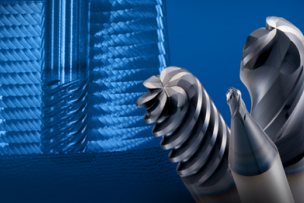Rethinking designs is not only for existing parts. It can apply to new parts that lead to new business. Using 3D printing, Allegheny Technologies Inc. (ATI) created a new part for a helicopter to stop an oil leak. The resulting part was lighter and more effective than anything that had been made through traditional manufacturing, and it was made more quickly.
Software to Help Meet Material Requirements
A fundamental challenge with 3D printing is getting the same material properties as traditional methods. With AM, the material is being made at the same time as the shape, and many variables affect the final product—what machine setting to use, what kind of feed stock to use, what kind of post processing to use. Understanding how these factors relate can be more than humans are capable of. But there is a solution for this, in the form of machine learning software.
“Machine learning, as an analytical approach, is a very good way for people to understand and tease out the relationship between the AM process and the end result,” Wang says. “For example, out of 10 levers or knobs on a machine, which ones matter? Some of them will not impact your material properties in the least. Some of them matter a lot. Some of them matter a little bit. Some of them might only matter in certain instances.”
Read more: The Unique Challenges and Solutions in Metal 3D Printing
Wang continues: “The software does your DOE—your design of experiment—for you, and then you empirically generate the training dataset, and then you feed that dataset back into the machine learning software, which then analyzes that data, and then it’ll start telling you which of the parameters matter and don’t matter, when they matter and how much they matter. It can even guide you to generating additional training datasets that you can use to improve your model and decrease your uncertainty.”
Part Consolidation to Streamline Operations
Advances in metal 3D printing are solving for the challenge of many parts needed to create one larger component. Instead of joining a number of parts together, a manufacturer can make one part with 3D printing.
“It’s a lot faster, potentially, for you to make one thing instead of 20 things and fasten them together,” Wang says. “There are also some administrative advantages. Instead of you keeping an inventory of 20 individual things, you keep an inventory of only one thing.”
A downside to 3D printing large metal parts is the slow process, which could be preventing wide adoption among manufacturers. But innovators are working on that. Seurat Technologies, for example, is developing a new type of laser distribution to print larger parts faster.
Mass Customization
3D printing requires no molds or fixed tooling, eliminating the need for time-consuming (and costly) setups that typically prevent smaller run sizes. Additive manufacturers, therefore, are able to mass-customize parts in any run size.
This flexibility is especially valuable in industries that call for product variety and individualization. Germany-based Vectoflow, for example, promotes its ability to print metal fluid-measurement probes customized for every application. In the dental industry, HP Inc. mass-customizes metal 3D printed parts to suit an individual’s needs for restorations.
Improved 3D Printing Methods to Reduce Defects
Printed metal, like most fabricated metal, can include defects, which compromises material strength and durability, an obvious concern that is being addressed. Researchers recently experimented with a form of laser powder bed fusion, a popular 3D printing method, and discovered it produced high-quality parts.
“We demonstrate a potential way to solve the quality problem by making metal 3D printing technology much more reliable, enabling it to produce consistent, defect-lean parts,” says Lianyi Chen, a mechanical engineering professor who was involved in the study. “Using our unique method, we were able to 3D print a metal part that has very few defects and a comparable quality to that of a commercially manufactured part that you could buy off the shelf.”
Read more: Additive Manufacturing: 5 Things You Need to Know About 3D Printing
Advances in materials are happening, too. Companies such as ATI—which supplies metal powder for 3D printers and also prints parts—are continually revisiting the composition of their metal powder to improve results.
Printing of Spare Parts
Need a welding fixture for a specialized order? Did a bracket break on the CNC machine that leaves the door open? Make one on the 3D printer.
Mercedes-Benz applies this principle to maintaining older vehicles. According to advisor McKinsey & Co., the automaker prints the spare parts on demand instead of storing them just in case.
Printing parts as needed is relatively quick, and it frees the company from having to keep parts in inventory or scramble to order them amid supply chain woes.
“If something breaks, being able to print a spare part and get your equipment back up and running is critical,” says Michael Mignatti, vice president of engineering at MakerBot Industries LLC, a manufacturer of 3D printers. “The printer is a real flexible tool. When you make that investment, you can look around and see the applications and areas where you can put it to work.”
What can your company most use metal 3D printing to accomplish? Share your thoughts in the comments below.






Talk to Us!
Leave a reply
Your email address will not be published. Required fields are marked *